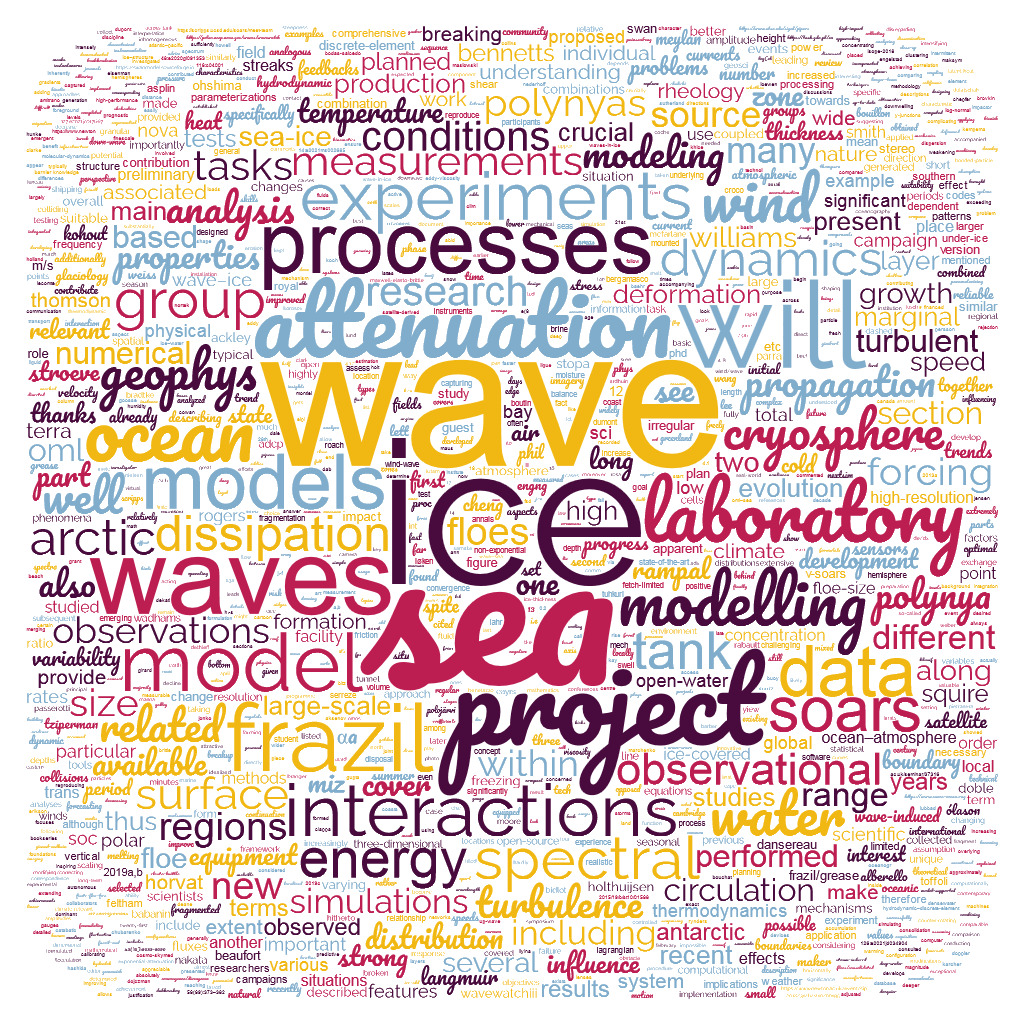Sea ice, waves and turbulence – from laboratory scale to improved large-scale
modelling
Polish National Science Centre project No. 2022/47/B/ST10/01129 ("OPUS-24" Programme)
Basic information
- Project leader: Agnieszka Herman
- Project length: 48 months, starting from July 2023

(word cloud created from the project description)
Project objectives
The subject of the project are interactions between sea ice, wind-generated ocean waves and turbulence in the
ocean mixed layer (OML). The main motivation behind the individual project objectives listed below is the fact
that, first, turbulent processes have been largely neglected in the hitherto sea ice research, and second, there is
growing observational evidence that those processes contribute substantially to the OML dynamics and wave–ice
interactions in sea-ice covered seas. More specifically, the project concentrates on two types of situations and
the associated groups of processes:
- under-ice turbulence accompanying wave propagation in sea ice, and the related wave energy attenuation,
- interactions between Langmuir circulation, waves and frazil ice dynamics and production in coastal polynyas.
As will be elaborated in detail in the further parts of this document, situations (1) and (2) differ in many
crucial aspects, but they also share several common features. The differences make them an interesting and
inspiring tandem. Thanks to the similarities they can be studied in a laboratory in a combined fashion, within
a sequence of experiments in which the outcome of one group of tests (2) can be used as a starting point for
the other group (1). This innovative concept of wide-ranging experiments is possible thanks to the Scripps
Ocean–Atmosphere Research Simulator (SOARS), a new, unique research facility at the Scripps Institution of
Oceanography (California, USA). SOARS, which combines a wave tank (filled with ocean water) with a wind
tunnel, has been designed specifically to study ocean–atmosphere interactions under very dynamic, turbulent
conditions, including polar regions (i.e., high waves and wind speeds, low air temperature).
The main objectives of the proposed project are:
- To create an observational database related to the two groups of processes (a) and (b) listed above, based
on a series of laboratory experiments at SOARS. In particular, to collect data on:
- turbulent kinetic energy (TKE) dissipation in the boundary layer under ice, and the associated wave
energy attenuation, for a range of wave and ice conditions (varying wave periods and amplitudes,
monochromatic and spectral waves; varying ice types, thickness and floe sizes),
- spectral evolution of fetch-limited waves in presence of frazil ice; influence of frazil on bulk water
viscosity and TKE dissipation; three-dimensional (3D) distribution of frazil in the OML in relationship
to the wave forcing and properties of the Langmuir circulation; influence of frazil on ocean–atmosphere
heat and moisture fluxes and aerosol production.
- To use the collected laboratory data to validate and, if necessary, improve the new source term for spectral
wave models describing dissipation due to under-ice turbulence, developed recently by Herman (2021) and
based on Weber (1991). In particular, to test the suitability of the eddy-viscosity model, relating the
turbulent shear stress to vertical gradients of velocity within the boundary layer, as an underlying model
for that source term.
- To use the improved, validated source terms in realistic WaveWatchIII and SWAN (Simulating WAves
Nearshore) simulations in order to assess the contribution of turbulent dissipation to the total wave energy
attenuation in sea ice in various wave forcing and ice conditions in the Arctic and Antarctic.
- To develop further the OML+frazil model by Herman et al. (2020) in order to make it suitable for realistic
simulations in coastal polynyas. In particular, to implement in the model frazil thermodynamics. To use the
model, together with laboratory data and high-resolution satellite imagery, to improve our understanding
of interactions between polynya dynamics, wave growth and frazil processes.
- To formulate a (set of) wave growth and dissipation source term(s) for spectral wave models suitable for
turbulent conditions with frazil/grease ice, and to describe source terms balance in fetch-limited, strongwind
situations characteristic of coastal polynyas.
In a wider perspective, the project will provide valuable observational (laboratory) data, freely available to
the scientific community, for validating parameterizations used in coupled models of sea ice, waves and ocean
circulation, including processes and situations not covered by the specific goals above. It will also provide
scientists with modelling tools (open-source programme codes) applicable to a wide range of problems. Thus,
the overall goal is to contribute to our – still limited – understanding of processes important for climate, including
sea ice and deep water formation in coastal polynyas, or seasonal and longer-term evolution of the marginal ice
zone (MIZ), in a longer perspective leading to the development of models with improved predictive skills.
|
